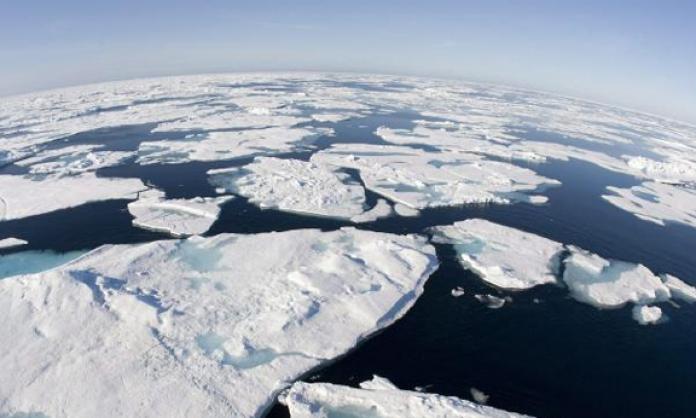The Arctic is warming faster than anywhere else in the world. If current trends continue, the Arctic Ocean could be completely ice-free in summer by the late 2030s. This may be a boon for big business – think new shipping routes and vast reserves of previously inaccessible oil, gas and other resources – but it would be a disaster for the planet.
A new report, Snow, Water, Ice and Permafrost in the Arctic, published by the Arctic Monitoring and Assessment Programme, details the dramatic extent of Arctic warming and its current and possible future impacts. The report was compiled with the help of 90 scientists and was commissioned by the Arctic Council – a grouping of countries bordering the Arctic including the US, Russia, Canada, Sweden, Denmark, Norway, Finland and Iceland.
The report’s findings were summarised by Rafe Pomerance, chairman of environmental NGO Arctic 21, in an interview with the journal Nature: “[T]he take-home message is that the Arctic is unravelling”. Over the past 50 years, the Arctic has warmed twice as fast as the global average. And in the past five years, the temperature rises have accelerated. According to the report:
“January 2016 in the Arctic was 5°C warmer than the 1981-2010 average for the region, a full 2°C higher than the previous record set in 2008, and monthly mean temperatures in October through December 2016 were 6°C higher than average.”
The rise in temperatures is leading to a rapid melting of ice and a reduction in snow cover. In the past decade, record lows for the area of summer minimum and winter maximum sea ice cover have been recorded.
The report notes that “sea ice thickness in the central Arctic Ocean declined by 65 percent over the period 1975-2012”. The thinner the ice, the more prone it is to breaking up and melting. As warming continues in the coming decades, the rate of the decline in ice coverage is likely to accelerate.
The melting of ice in the Arctic Ocean and on the Greenland ice sheet is bad news for coastal communities around the world. The Arctic has, since the early 1970s, been the main driver of rising sea levels.
Scientists currently forecast a 74 centimetre rise by the end of the century. The report suggests this could end up being way under the mark. Between 2011 and 2014, Greenland, which makes up 70 percent of the Arctic’s overall contribution to sea level rises, lost ice at almost twice the rate of the period from 2003 to 2008.
Rising seas aren’t the only problem. According to the report, “By altering the salinity and temperature of different parts of the sea, circulation patterns both within the Arctic Ocean and, consequently, in the atmosphere will change. That will affect weather and climate phenomena, such as India’s monsoon season, thousands of miles to the south”.
The melting of snow and ice also reduces the white area of the earth’s surface that reflects sunlight back into space. The report notes that “in recent years, June snow area in the North American and Eurasian Arctic has typically been about 50 percent below values observed before 2000”. The increasing absorption of light contributes to further warming in these areas.
Perhaps the biggest threat, however, lies in the melting of the permafrost. This is an area of land surrounding the Arctic, where the soil beneath the surface remains frozen throughout the year. Were the permafrost to melt, vast amounts of carbon and methane currently trapped in the soil would be released into the atmosphere. This would likely wipe out any efforts made to reduce emissions from human activities, leading us into the nightmare scenario of uncontrollable, runaway warming.
The report’s overall prognosis for the Arctic is dire: “With each additional year of data, it becomes increasingly clear that the Arctic as we know it is being replaced by a warmer, wetter, and more variable environment. This transformation has profound implications for people, resources and ecosystems worldwide”.
We’re not talking about the possibility of beach holidays in Alaska. The consequences of the Arctic’s “unravelling” would be devastating – for the environment, for the economy and for society. The report refers to economic research on the possible global cost of a warming Arctic – estimated at between US$7 trillion and US$90 trillion from 2010 to 2100.
You’d think, if nothing else, that these stupendous sums would give our leaders pause for thought. Unfortunately, there’s little indication they care.
When you understand their roles as managers of the capitalist system, this makes sense. Capitalism is about short term profits for the wealthy few. The long term costs of climate change are of little interest to them. In contrast to the profits they stand to reap from the continued exploitation of fossil fuels, these costs can be socialised – pushed onto the backs of the poorest and most vulnerable.
In late April, Donald Trump signed an executive order to “unleash American energy” by getting rid of restrictions on oil drilling in the Arctic and Atlantic. This was his answer to unfolding climate catastrophe in the region. We need to fight him, and his fellow fossil-capitalists in Australia and around the world, every step of the way.











